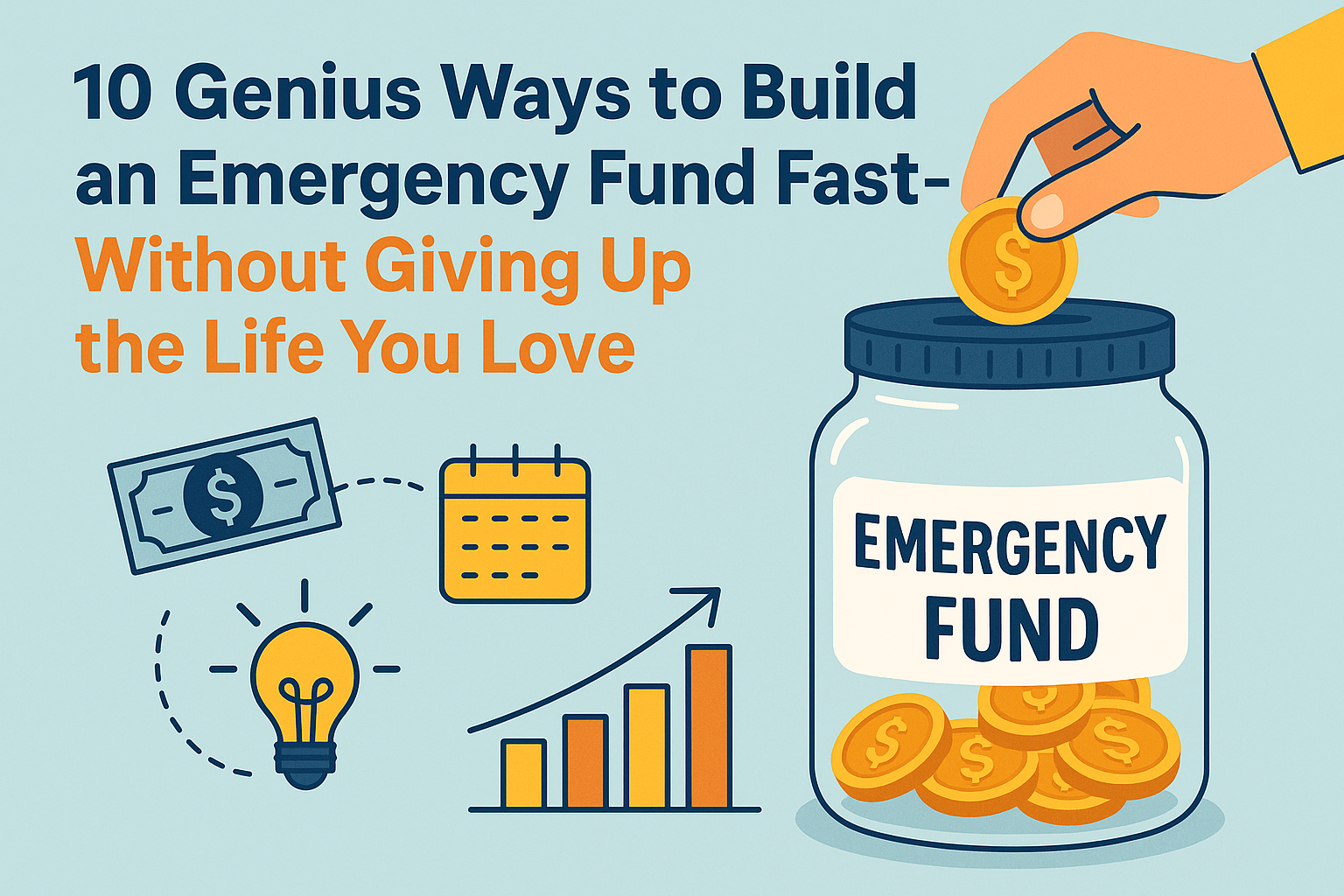
simply amazing, always for you.
Let’s face it—life throws curveballs. Your car breaks down, a pet gets sick, or your hours get cut at work. In moments like these, an emergency fund isn’t just nice to have—it’s a lifeline.

But here’s the catch: building one feels impossible when you’re already stretching every dollar. You’ve got bills, responsibilities, and a social life. So how do you save fast without feeling broke or boring?
Good news: you don’t have to become a hermit or give up your favorite coffee shop to build a solid financial cushion.
In this post, we’ll show you how to build an emergency fund quickly—without killing your lifestyle.
What Exactly Is an Emergency Fund?
An emergency fund is a stash of money set aside specifically for unexpected expenses like:
- Medical emergencies
- Job loss
- Urgent home or car repairs
- Family crises
The goal? To keep you from going into debt when life hits you hard.
How Much Should You Save?
Financial experts recommend 3 to 6 months of essential expenses, but don’t let that number scare you. If you spend $2,000/month on necessities, a 3-month fund would be $6,000.
Sound like a lot? That’s okay. Start with a mini-goal of $1,000. Then build from there.
Why You Need It—Even If You Think You Don’t
You may feel secure with a steady paycheck or multiple income streams. But here’s the truth:

Emergencies don’t wait until you’re ready.
In fact, 78% of Americans live paycheck to paycheck, and nearly 60% can’t cover a $1,000 emergency without borrowing.
Whether you’re single, married, or supporting a family, your future self will thank you for taking action now.
The Fast-Track Plan: How to Build an Emergency Fund—Without Killing Your Vibe
Here’s a strategy that works with your life, not against it.
1. Automate Your Savings (Before You Notice It’s Gone)
The #1 way to save without effort? Automate it.
- Set up a direct deposit split—send a portion of your paycheck directly to a high-yield savings account.
- Can’t do that? Use an app like Chime, Ally, or Capital One 360 to set up automatic transfers weekly or biweekly.
Even $25 per week = $1,300/year. Start small and increase when possible.
2. Create a “No-Touch” High-Yield Savings Account
Avoid keeping your emergency fund in your main bank.
- Choose a high-yield savings account (HYSA) from online banks like Marcus by Goldman Sachs, Discover, or American Express that earn 4–5% APY.
- Make it inconvenient to access quickly so you don’t dip into it for non-emergencies.
- No debit card. No mobile check deposits. Just pure saving.
3. Cut the Fluff—Not the Fun
You don’t have to live like a monk. Just trim what doesn’t serve you.
Try these:
- Pause subscriptions you forgot you had (use Truebill or Rocket Money).
- Swap 2 takeouts per week for 1.
- Cancel the gym you never go to and walk, run, or YouTube at home.
- Cook once, eat twice—save money and time.
By saving $50–$100 per month in small tweaks, you won’t feel the pinch but your emergency fund will grow.
4. Turn Clutter Into Cash (Garage Sale Your Life)
Walk around your house. You probably have:
- Old phones
- Clothes you don’t wear
- Gadgets collecting dust
- Furniture you barely use
Sell it all. Use:
- Facebook Marketplace
- eBay
- Poshmark
- Decluttr
- OfferUp
You could easily make $300–$1,000 fast without missing a thing.
5. Embrace the 24-Hour Rule
Impulse spending is a fund killer.
Before buying anything unplanned:
- Wait 24 hours.
- Ask: Do I really need this?
- Redirect that money to your emergency stash.
Small tweaks like this can easily reroute $100+ per month toward your fund.
6. Use Windfalls to Supercharge Your Fund
Got a tax refund, work bonus, or birthday cash?
Split it:
- 50% to your emergency fund
- 25% to fun money
- 25% to debt or investing
Even a $500 refund gives your fund a big bump without denying yourself a reward.
7. Pick Up a Quick Side Hustle (Temporary Boost)
You don’t have to hustle forever—just until your fund hits your goal.
Easy wins:
- Uber, Lyft, or DoorDash on weekends
- Freelance writing, editing, or design on Upwork or Fiverr
- Pet sitting on Rover
- Virtual tutoring on Cambly
- Babysitting or cleaning gigs
Doing this even part-time for a month or two could net $500–$2,000.
8. Save Spare Change Automatically
Apps like:
- Acorns
- Qapital
- Digit (now part of Oportun)
Round up your purchases and save the change. If you spend $3.60, the app rounds it to $4 and stashes $0.40.
It adds up faster than you think—especially if you combine it with other strategies.
9. Gamify Your Savings
Make saving fun. Challenge yourself to:
- No-Spend Weekends
- $5 Challenge (save every $5 bill you get)
- Savings Bingo (create a sheet with amounts from $1 to $50 and fill in each square you save)
These turn saving into a game and make it less painful.
10. Tell Your Friends—Not to Lend, But to Support
Let trusted friends know you’re on a savings journey. Not so they’ll spot you—but so they’ll:
- Support budget-friendly hangouts
- Skip pressuring you to overspend
- Celebrate your milestones
A supportive circle = less temptation, more accountability.
What Not to Do (Common Emergency Fund Mistakes)
Avoid these fund-killers:
Using a regular checking account
You’ll dip into it easily. Out of sight = out of reach.
Saving while ignoring debt with high interest
If your credit card charges 24% APR, prioritize paying that down alongside building a $500–$1,000 mini-fund.
Treating your fund like a vacation fund
It’s for emergencies only—not birthdays, trips, or a new phone.
How Fast Can You Build It?
That depends on:
- Your current income and expenses
- Your level of commitment
- Side income or windfalls
If you’re focused, you can build a $1,000 starter fund in:
- 2–4 weeks with side income
- 2–3 months with budget changes alone
Once you hit your starter goal, keep going until you reach 3–6 months of essential expenses.
Real-Life Example: Emily’s 3-Month Emergency Fund in 90 Days
Emily, 29, a graphic designer, earned $3,000/month post-tax. She wanted $6,000 for a solid emergency fund.
Here’s what she did:
- Paused her $100/month subscription box habit
- Sold $800 worth of unused clothes and electronics
- Picked up weekend gigs designing Canva templates for small businesses
- Saved her $1,200 tax refund
Result? She saved $6,300 in 90 days—without once skipping brunch.
Security Without Sacrifice
You don’t need to slash every joy out of your life to get ahead financially.
By building an emergency fund quickly—and smartly—you’re giving yourself:
- Peace of mind
- Protection from debt
- Power over your future
So yes, you can build that safety net without turning into a joyless budget zombie.
Start small. Start today. Just start.

Support Our Website!
We appreciate your visit and hope you find our content valuable. If you’d like to support us further, please consider contributing through the TILL NUMBER: 9549825. Your support helps us keep delivering great content!
If you’d like to support Nabado from outside Kenya, we invite you to send your contributions through trusted third-party services such as Remitly, SendWave, or WorldRemit. These platforms are reliable and convenient for international money transfers.
Please use the following details when sending your support:
Phone Number: +254701838999
Recipient Name: Peterson Getuma Okemwa
We sincerely appreciate your generosity and support. Thank you for being part of this journey!
